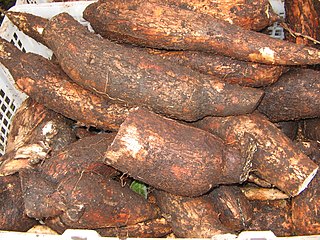Cauim is a traditional alcoholic beverage or beer of the indigenous peoples in Brazil since pre-Columbian times. It is still made today in remote areas throughout Panama and South America. Cauim is made by fermenting manioc (a large starchy root), or maize, sometimes flavored with fruit juices. The Kuna Indians of Panama use plantains.
In Spanish it is called chicha de yuca or in some places (like Peru) masato . The best term in English may be "Manioc beer". In Kichwa, Lumu Asua. In Shuar, Nijiamanch. In Paicoca, Co'n.
A characteristic feature of the beverage is that the starting material is cooked, chewed, and fermented, so that enzymes (including amylase) present in human saliva can break down the starch into fermentable sugars. (This principle was originally used also for Japanese sake.) [1]
The following description, largely from Jean de Léry's account of his trip to Brazil in the 16th century [2] applies specifically to the Tupinambá natives who lived along the coast of central Brazil. However, it is typical of other tribes throughout Brazil.
Cauim preparation (like other cooking tasks) is strictly a women's job, with no involvement from the men. Manioc roots are sliced thin, boiled until tender, and allowed to cool down. Then women and girls gather around the pot; each repeatedly takes a mouthful of manioc, chews it, and puts it into a second pot (depending on the culture). Enzymes in the saliva then convert the starch into fermentable sugars. (Men firmly believe that if they were to chew the paste, the resulting beverage would not taste as good; and anyway they consider that work as inappropriate for them as spinning yarn would be for European men.) The chewed root paste is put back on the fire and stirred with a wooden spoon until completely cooked. The paste is then allowed to ferment in large earthenware pots ("half as big as a Burgundy wine barrel").
The resulting beverage is opaque and dense like wine dregs and tastes like sour milk. There are light and dark varieties of cauim, and the beverage can be flavored with various fruits.
The same process is used to make a similar beverage from maize. Since both plants grow abundantly throughout the year, the natives prepare the beverage in any season, sometimes in large quantities. Cauim can be consumed quietly by one or two people, but is most commonly consumed at parties with tens or hundreds of people, often from two or more villages. According to contemporary records, thirty or more large pots of cauim could be consumed in a single party; and "neither the German, nor the Flemish, nor the soldiers, nor the Swiss — that is, none of those people in France who devote themselves to great drinking, will match the Americans in that art." Cauim was also de rigueur in solemn occasions, such as the ceremonial killing and eating of a war prisoner.
Serving the cauim at parties is also a women's task. Cauim is better consumed warm, and so the women will place the pots over a slow fire in the village's central plaza. While keeping the pot well stirred, they will serve the beverage in drinking bowls — holding up to "three Parisian quarts" each — to the dancing men, as they pass by. While men are supposed to empty their bowls in one go (and perhaps twenty bowlfuls in a single party), the women take sips more or less continuously.
A drinking party could go on for two or three days, with music, dancing, whistling, and shouting going on all the time. Sometimes the men would force themselves to throw up in order to continue drinking. Leaving the party would be considered a great shame, "worse than schelm among Germans". Curiously, the Tupinambá do not eat during their drinking parties, just as they do not drink at meals; and they find the European custom of mixing the two things very strange.
Jean de Léry reports that he and his companions tried to prepare "clean" cauim by grinding and cooking manioc or maize, without the chewing step; but (predictably) it did not work. Eventually they got used to the natives' drink. "To those readers who are put off by the idea of drinking what someone else has chewed," adds the traveler, "let me remind them of how our wine is made ... by the peasants who trample on the grapes with their feet, sometimes with shoes and all; things that are perhaps even less agreeable than the chewing of American women. Just as one says that wine, by fermenting, rids itself of all impurity; so we may assume that cauim purges itself too."
Cauim is still made by many indigenous communities in Brazil and elsewhere in the Amazon. It is the main staple food for infants of the Tapirapé Indians of the Tapi'itãwa tribe (Mato Grosso state) until they are two years old. [3]
Analysis of cauim made from manioc showed that fermentation was due to a large variety of bacteria. [3] As the fermentation progressed, the species Lactobacillus pentosus and L. plantarum became dominant. The acidity of the final product was due to lactic acid but significant amounts of ethanol and acetic acid were present. A second analysis of cauim made from rice and manioc also showed the presence of yeasts, chiefly Candida tropicalis . [4]

Beer is one of the oldest alcoholic drinks in the world, the most widely consumed, and the third most popular drink after water and tea. Beer is produced by the brewing and fermentation of starches from cereal grains—most commonly malted barley, although wheat, maize (corn), rice, and oats are also used. The fermentation of the starch sugars in the wort produces ethanol and carbonation in the beer. Most modern beer is brewed with hops, which add bitterness and other flavours and act as a natural preservative and stabilising agent. Other flavouring agents, such as gruit, herbs, or fruits, may be included or used instead of hops. In commercial brewing, natural carbonation is often replaced with forced carbonation.

Homebrewing is the brewing of beer or other alcoholic beverages on a small scale for personal, non-commercial purposes. Supplies, such as kits and fermentation tanks, can be purchased locally at specialty stores or online. Beer was brewed domestically for thousands of years before its commercial production, although its legality has varied according to local regulation. Homebrewing is closely related to the hobby of home distillation, the production of alcoholic spirits for personal consumption; however home distillation is generally more tightly regulated.

Chicha is a fermented (alcoholic) or non-fermented beverage of Latin America, emerging from the Andes and Amazonia regions. In both the pre- and post-Spanish conquest periods, corn beer made from a variety of maize landraces has been the most common form of chicha. However, chicha is also made from a variety of other cultigens and wild plants, including, among others, quinoa, kañiwa, peanut, manioc, palm fruit, rice, potato, oca, and chañar. There are many regional variations of chicha. In the Inca Empire, chicha had ceremonial and ritual uses.

Rice wine is a generic term for an alcoholic beverage fermented from rice, traditionally consumed in East Asia, Southeast Asia and South Asia. Rice wine is made by the fermentation of rice starch, during which microbes enzymatically convert its starches to sugar. Sake in Japan, Mijiu in China, and Cheongju and Makgeolli in Korea are some of the most notable types of rice wine.

Ethanol fermentation, also called alcoholic fermentation, is a biological process which converts sugars such as glucose, fructose, and sucrose into cellular energy, producing ethanol and carbon dioxide as by-products. Because yeasts perform this conversion in the absence of oxygen, alcoholic fermentation is considered an anaerobic process. It also takes place in some species of fish where it provides energy when oxygen is scarce.

Kilju is the Finnish word for home made alcoholic beverage typically made of sugar, yeast, and water.

Purposeful production of alcoholic drinks is common and often reflects cultural and religious peculiarities as much as geographical and sociological conditions.

Beer is one of the oldest human-produced drinks. The first chemically confirmed barley-beer – from the area of Mesopotamia, part of modern-day Iraq – dates back to the 5th millennium BCE. The written history of ancient Egypt and Mesopotamia records the use of beer, and the drink has spread throughout the world; a 3,900-year-old Sumerian poem honouring Ninkasi, the patron goddess of brewing, contains the oldest surviving beer-recipe, describing the production of beer from barley bread, and in China, residue on pottery dating from around 5,000 years ago shows that beer was brewed using barley and other grains.

In food processing, fermentation is the conversion of carbohydrates to alcohol or organic acids using microorganisms—yeasts or bacteria—under anaerobic (oxygen-free) conditions. Fermentation usually implies that the action of microorganisms is desired. The science of fermentation is known as zymology or zymurgy.
Tesgüino is an artisanal corn beer produced by several Yuto-Aztec people. The Tarahumara people regard the beer as sacred, and it forms a significant part of their society. Anthropologist John Kennedy reports that "the average Tarahumaras spends at least 100 days per year directly concerned with tesgüino and much of this time under its influence or aftereffects."

A great variety of cassava-based dishes are consumed in the regions where cassava is cultivated, and the ingredient is included many national or ethnic specialities.

The cuisine of Rwanda is based on local staple foods produced by the traditional subsistence-level agriculture and has historically varied across different areas.

Chicha de jora is a corn beer or chicha prepared by germinating maize, extracting the malt sugars, boiling the wort, and fermenting it in large vessels for several days. The process is essentially similar to the process for the production of European-style beer. Some add quinoa or other adjuncts to give it consistency before it is boiled down. Chancaca, a hard raw form of cane sugar, helps with the fermentation process.

Nihamanchï is a beer brewed from cassava by indigenous peoples of South America. It is also known as nihamanci, nijimanche, or nijiamanchi, and is related to chicha.

Huangjiu is a type of Chinese rice wine most popular in the Jiangnan area. Huangjiu is brewed by mixing steamed grains including rice, glutinous rice or millet with qū as starter culture, followed by saccharification and fermentation at around 13–18 °C (55–64 °F) for fortnights. Its alcohol content is typically 8% to 20%.

Masato is a beverage made from cassava, rice, corn, oats, or pineapple. Its preparation involves fermenting these ingredients in a pot with water for approximately 8 days, until the mixture begins to foam. Like other alcoholic beverages, it is produced through microbial fermentation, especially by various types of Lactobacillus.